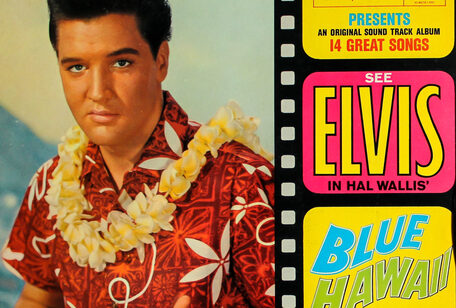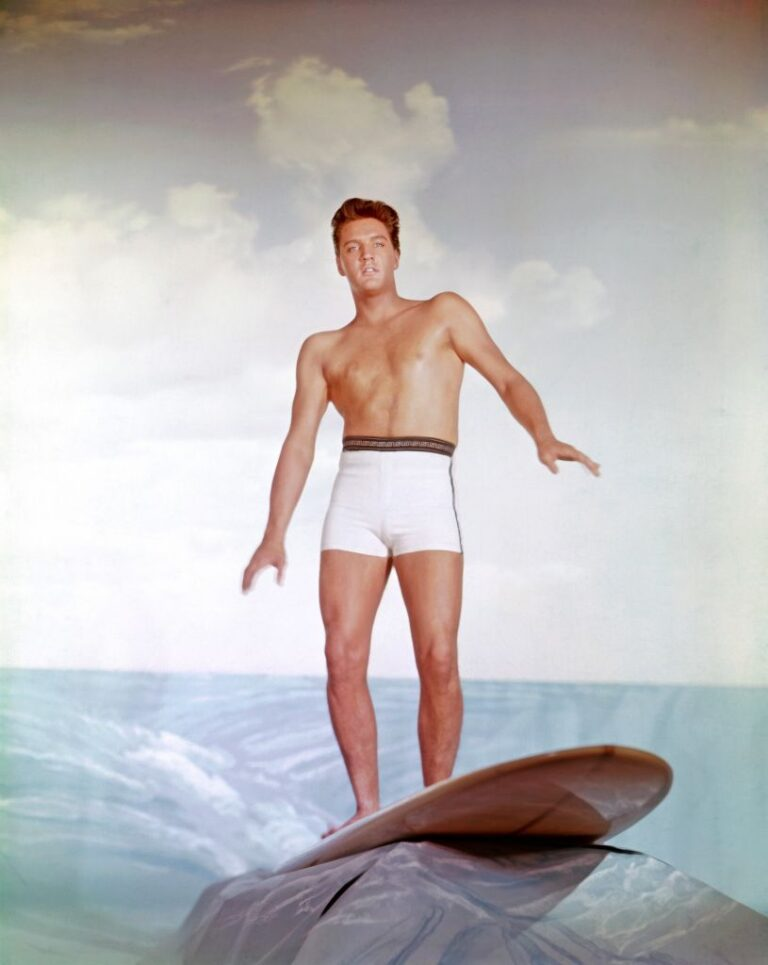When Blue Hawaii hit theaters in 1961, it wasn’t just another Elvis Presley movie—it was a turning point. Departing from his earlier roles as a musician or performer, Elvis played Chad Gates, a former G.I. who returns to the Hawaiian Islands to escape the pressures of his family’s expectations. While Chad wasn’t a professional musician, the film seamlessly wove Elvis’s music into its storyline, setting the tone for many of his future projects.
This shift marked a new era for Elvis’s career, solidifying a formula that would dominate his filmography: exotic locations, lighthearted romance, and a soundtrack packed with hits. With Blue Hawaii, Elvis and his manager, Colonel Tom Parker, discovered a recipe for box office success, propelling him into the upper echelons of Hollywood’s leading men throughout the 1960s.
The Soundtrack That Became a Cultural Staple

One of the defining features of Blue Hawaii is its unforgettable soundtrack. With 14 songs, it contains more music than any other Elvis movie, turning the film into a feast for fans.
- “Can’t Help Falling in Love”: The standout ballad became an instant classic, climbing to No. 2 on the Billboard Hot 100. Decades later, it remains one of Elvis’s most cherished songs, a staple at weddings and romantic events worldwide.
- “Rock-A-Hula Baby”: This upbeat number showcased Elvis’s playful side, perfectly blending rock and Hawaiian-inspired rhythms.
- “Hawaiian Wedding Song”: This serene tune became an anthem for love and romance, encapsulating the film’s tropical charm.
The soundtrack not only complemented the film’s breezy vibe but also resonated with audiences far beyond the theater, cementing its place in music history.
Behind-the-Scenes Bloopers and Hidden Gems
While Blue Hawaii is remembered for its polished aesthetic, it’s peppered with amusing bloopers and quirks that sharp-eyed viewers can’t help but notice. These subtle mishaps add an endearing layer to the film.
- The Mysterious Steering Wheel: In the “Almost Always True” scene, Maile’s hand placement on the steering wheel changes mid-shot, and Chad’s arm inexplicably shifts from resting on the seatback to behind Maile.
- Ellie’s Seat Switch: In a scene set in a pineapple field, Ellie starts in the back seat of a car but magically appears in the front passenger seat without explanation.
- The Static Ukulele: During one of Chad’s musical performances, his ukulele-playing doesn’t quite match the chords heard in the song. It’s a blink-and-you’ll-miss-it detail that adds charm to the scene.
These minor errors didn’t detract from the film’s overall appeal—instead, they make it even more endearing to fans who love discovering little surprises.
Elvis Presley’s Pranks and Personality
Elvis’s charisma didn’t just shine on-screen; it was just as evident behind the scenes. Known for his sense of humor, he kept the Blue Hawaii set lively with his pranks. One infamous stunt involved faking a dramatic collapse in front of his entourage, only to sit up moments later, laughing at their panicked reactions. It’s a glimpse into Elvis’s playful personality, which balanced the pressures of fame with moments of lighthearted fun.
Hawaii: More Than Just a Backdrop

For Elvis, Hawaii wasn’t just a picturesque filming location—it was a place close to his heart. Blue Hawaii was the first of three films he shot in the islands, and the connection didn’t stop there. Elvis returned to Hawaii repeatedly for vacations and iconic performances, including his 1973 Aloha from Hawaii via Satellite concert.
One standout location in the film was the Coco Palms Resort, where Chad and Maile’s wedding scene was filmed. The resort became synonymous with the movie, attracting fans and tourists for years. Though it was damaged by Hurricane Iniki in 1992, the site still holds sentimental value for those who associate it with the King’s cinematic legacy.
The 1960 MGA Roadster: An Iconic Co-Star
Another scene-stealer in Blue Hawaii was Chad’s red 1960 MGA 1600 MkI roadster. This sleek car perfectly matched Elvis’s cool, carefree character. Elvis reportedly loved the car so much that he purchased it after filming wrapped. Today, the roadster is a prized piece in the Graceland collection, reflecting Elvis’s love for stylish vehicles.
The Challenges Behind the Sunshine
While Blue Hawaii was a box office triumph, it wasn’t without its challenges for Elvis. Privately, he struggled with the lightweight scripts and formulaic nature of his movie roles. Anne Fulchino, a publicity director who visited the set, recalled seeing Elvis frustrated by the creative limitations of his film career. Despite this, his professionalism and natural charisma ensured that his performances never faltered.
A Lasting Connection to the Aloha State

Elvis’s relationship with Hawaii extended beyond his films. Just months before his death in 1977, he took one final trip to the islands, staying at the Hilton Rainbow Tower and later a private beach house. It was a poignant farewell to a place that had brought him so much joy.
Why Blue Hawaii Endures
More than 60 years after its release, Blue Hawaii remains a cultural touchstone. Its stunning Hawaiian landscapes, iconic soundtrack, and Elvis’s undeniable charm make it a timeless classic. Fans continue to revisit the film for its feel-good atmosphere and the memories it evokes of a simpler, sunnier time.
Conclusion: A Movie That Defined an Era
Blue Hawaii isn’t just a movie—it’s a celebration of everything that made Elvis Presley a star. From the lush Hawaiian scenery to the unforgettable soundtrack, the film captures the King of Rock ‘n’ Roll at his peak. While it may not have been the most critically acclaimed project of his career, it cemented his status as a beloved entertainer and introduced audiences to a new side of his talent.
Whether you’re a longtime fan or discovering the film for the first time, Blue Hawaii offers a nostalgic escape to a world of romance, music, and tropical charm. So next time you watch, keep an eye out for those hidden bloopers—and let yourself be swept away by the magic of Elvis in paradise.


